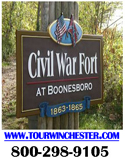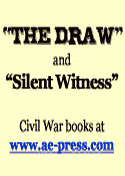



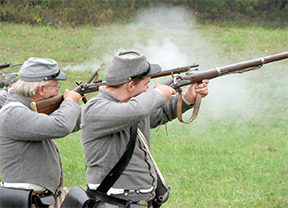
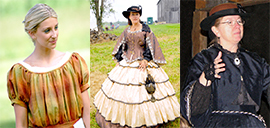
Deadly volley
Confederate re-enactors at
Camp Wildcat are totally
focused on their target
during October re-enactment
action. Approximately
2,500 people attended
Wildcat’s annual event.
See “News in Brief” for
more details.
– Danna Estridge photo
Confederate re-enactors at
Camp Wildcat are totally
focused on their target
during October re-enactment
action. Approximately
2,500 people attended
Wildcat’s annual event.
See “News in Brief” for
more details.
– Danna Estridge photo
Distaff re-enactors lent authenticity and color
recently to Civil War events at Richmond and
Camp Wildcat. Mackenzie Humphrey (left) helped
coordinate living history activities at Richmond
while Debbie Vahle (center) added a Southern Belle atmosphere to Richmond’s re-enactment weekend.
Joan Howard (right) portrayed Varina Davis,
widow of Confederate President Jefferson Davis,
at Wildcat.
– Photos by George Terrizzi, JK Photography
and Danna Estridge
| In this issue ... Louisville's Larry Elliott His Lincoln portrayal ranks No. 1 Who does the best portrayal of Abraham Lincoln? According to judges in the birthplace of the 16th president, the answer is Larry Elliott. Elliott, a retired Louisville insurance representative who has been portraying Lincoln for six years, won the Lincoln Days Celebration Lincoln Look-a-Likes contest last October. Read more 'A four-five year process' Mill Springs seeks national park status Kentucky’s next national park could be located in Pulaski County. Officials of the Mill Springs Battlefield Association have asked the Pulaski County Fiscal Court to aid them in establishing the Civil War battlefield as a national park. Gilbert Wilson, director of the Association, has presented the court with a resolution in which it would request the federal government to grant the battlefield national park status. The fiscal court has approved the resolution, which was submitted after several years of consideration. Read more 'Hail to the Chief' was last music heard by Civil War's assassinated president By LINDA ASHLEY Bugle Contributing Writer The strains of “Hail to the Chief” filled Ford’s Theater the fateful night of April 14, 1865, as President and Mrs. Lincoln took their seats. Only five days earlier, Gen. Robert E. Lee had surrendered to Gen. U.S. Grant, essentially ending the war, and so the crowd was happy and excited to greet the president. The play, “Our American Cousin,” was in the third act when the southern sympathizer, John Wilkes Booth, entered the box where the Lincolns were sitting and shot the president in the head. Amid the cries and confusion, the band once again began playing “Hail to the Chief” as the president was carried out of the theater and across the street to the Peterson home, where he died the following morning. The tune, played so often in his honor, was the last music Lincoln heard. Read more Although pro-Union, Kentucky did have Confederate governors Johnson, Hawes In answer to those readers who have asked… Yes, Kentucky did have a Confederate governor – in fact, it had two of them. Interestingly, Confederates, at one time, even briefly installed a Confederate governor in the state capital at Frankfort. Read more Johnson saw secession as preventative First CSA governor first leader fatality Scott County lawyer and farmer George Washington Johnson recorded several firsts during the Civil War. 1. He was Kentucky’s first Confederate governor, and 2. was the only state governor, Union or Confederate, to die in battle. Johnson’s death also set the stage for the selection of the Commonwealth’s second and last Confederate governor, Richard Hawes. Read more Although not convicted of murder, Davis was passed over for advancement in rank Ever know a soldier who wanted to shoot his commanding officer? Jefferson Columbus Davis not only wanted to, but did,and got away with it. It all happened at Louisville’s Galt House Hotel in 1862. Read more Kentucky's Crittendens Many headaches later, loyalties divided John Jordan Crittenden served four separate terms as a U.S. Senator from Kentucky, was U.S. attorney general on two occasions, was elected Kentucky governor and completed two terms as a state representative. That amounts to enough political headaches for a lifetime. But, with the coming of the Civil War, the Versailles native had one more in the offing. One son, Thomas, joined the Union army and the other, George, cast his lot with the Confederacy. Torn by loyalties, John Jordan Crittenden died before seeing both sons become generals and survive the War-Between-the-States. Read more Kentucky's Civil War Leaders Preston tried in vain to persuade state into joining movement for secession (EDITOR’S NOTE: This is the 10th in a series about Kentucky officers and battle leaders during the Civil War.) By PHILLIP SEYFRIT Bugle Staff Writer Confederate Brig. Gen. William Preston - military officer, legislator, congressman and diplomat – was a distinguished attorney in his native Louisville who used his considerable influence in trying to persuade Kentucky into secession during the Civil War. Educated in Kentucky and at Harvard, earning a law degree from the latter in 1838, Preston was appointed Lt. Colonel of the 4th Kentucky at the beginning of the Mexican War. He was elected to both houses of the Kentucky legislature in the 1840s and 50s and represented Kentucky in the U.S. Congress. He then was appointed minister to Spain by President James Buchanan in 1858. Read more This book tells you how Some keys to planning Civil War event “Helping History Come Alive,” by Danna Estridge and Juanita Westerfield, e-book, 84 pages, Booklocker Press, $9.95. Reviewed by ED FORD Bugle Editor Kentucky’s rich and formidable Civil War history is expected to intensify with additional battle sites and living history events as the Civil War Sesquicentennial approaches in 2011. That’s why an e-book by Laurel County authors Danna Estridge and Juanita Westerfield is so timely and appropriate. “Helping History Come Alive” is a concise, well-done volume that’s an excellent “how-to” in planning, organizing and promoting a Civil War re-enactment or living history event. Read more News in Brief Docudrama, horsemanship set at Camp Nelson Performance of a new docudrama, "Blow Ye the Trumpets, Blow,” and a world class exhibition of military horsemanship and Civil War history are among the event highlights scheduled at Camp Nelson. The play, subtitled, “The African American Refugees Struggle for freedom at Camp Nelson During the Civil War," is scheduled June 5-6 and the horsemanship program is on tap Sept. 30-Oct. 3. The four-day horsemanship exhibition will see military and civilian historians competing in a variety of competitions including cavalry tactics, individual and unit; artillery drill and marksmanship; and infantry drill, both individual and unit. Read more |

Best Lincolns
Larry and Mary Elliott, shown here with a student
group, continue to gain popularity with their
portrayals of Abraham and Mary Todd Lincoln.
Larry gave the No. 1 Lincoln impression at
Hodgenville’s Lincoln Days Celebration and Mary
took second place in the M.T. Lincoln competition.
See story. – photo by Scarlett Richardson
Larry and Mary Elliott, shown here with a student
group, continue to gain popularity with their
portrayals of Abraham and Mary Todd Lincoln.
Larry gave the No. 1 Lincoln impression at
Hodgenville’s Lincoln Days Celebration and Mary
took second place in the M.T. Lincoln competition.
See story. – photo by Scarlett Richardson
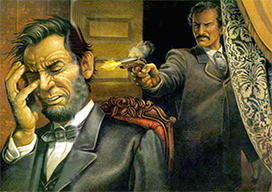
Somber finale
These sketches show President Abraham Lincoln
as he was assassinated by John Wilkes Booth
(above) and the set of “Our American Cousin”
(below) as it appeared on that night at Ford’s
Theatre. The Presidential box is the top curtained
area to the right.
See ‘Hail to the Chief’ story.
– Assassination Photo Gallery
These sketches show President Abraham Lincoln
as he was assassinated by John Wilkes Booth
(above) and the set of “Our American Cousin”
(below) as it appeared on that night at Ford’s
Theatre. The Presidential box is the top curtained
area to the right.
See ‘Hail to the Chief’ story.
– Assassination Photo Gallery

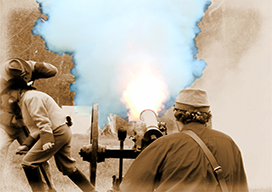
Fiery belch
The fire and thunder of a cannon’s burst, even with
a blank charge, is evident in this photo taken at
Leatherwood’s recent re-enactment weekend.
Laura Crutcher happened to catch the action
at just the right moment. – Laura Crutcher photo
The fire and thunder of a cannon’s burst, even with
a blank charge, is evident in this photo taken at
Leatherwood’s recent re-enactment weekend.
Laura Crutcher happened to catch the action
at just the right moment. – Laura Crutcher photo

Restoration
The Battle of Richmond Association is in the process
of restoring a pre-Civil War cemetery discovered on
the grounds of its Battlefield Park.The Kincaid
Cemetery is the resting ground of a family that
initially owned the acreage where much of the
1862 Battle of Richmond was fought.
– Linda Ashley photo
The Battle of Richmond Association is in the process
of restoring a pre-Civil War cemetery discovered on
the grounds of its Battlefield Park.The Kincaid
Cemetery is the resting ground of a family that
initially owned the acreage where much of the
1862 Battle of Richmond was fought.
– Linda Ashley photo
Articles and photos appearing on www.thekentuckycivilwarbugle.com may be used with permission. For permission, contact Bugle editor Ed Ford at fordpr@mis.net.
Back to top
Back to top




